Learn how to brew your own easy and delicious hard cider with this simple recipe! Brewing your own hard cider is easy, affordable, and it tastes amazing.
Homemade Hard Cider
This, right here, will change your world.
No, not in the “this is the best hard cider I’ve ever had, I should sell this stuff and make a bunch of money” kind of way, but in the “Wow, I just made my own homebrew and it’s pretty awesome and maybe I want to learn more about this” kind of way.
I first started making my own alcohol, mainly hard cider and mead (honey wine), when Joel and I lived in a dry county in Arkansas. Yes, dry counties still exist.
I always kept it pretty basic and was usually happy with the results, plus I learned a few tricks along the way.
I even wrote an ebook about Simple Mead Making for Beginners that explains everything in detail, which is a very similar process!
Hard Apple Cider Recipe
I’m going to show you how to make hard cider, which is one of my favorite ways to preserve apples. I think it is the easiest place as any to start brewing your own booze!
You will probably have to buy a few things to get started in your brewing adventure, but don’t worry, everything is relatively cheap. I will go over all of it with you.
Hard Apple Cider Ingredients & Equipment
I’m going to show you how to make one gallon of hard cider. Here is what you’ll need to begin your brew.
- Sanitizer: This is super important, do not skip this! I like One Step brand as it’s very easy to use and inexpensive.
- A large pot, a big funnel, a big spoon, and a ladle. You may not use the ladle, but it’s good to have it ready in case you need it.
- 1 gallon glass jug with cap and airlock: for fermenting the hard cider.
- 1 gallon apple juice without preservatives: Most preservatives mess up the fermentation (trust me, I’ve made that mistake), but citric acid is ok. I’ve used both Santa Cruz Organic or North Coast Organic brands of apple juice, and they have worked well. Better yet, make your own Apple Cider with fresh apples in the fall.
- 1 pound (16 ounces) brown sugar: more or less, depending on how sweet or dry you want your finished product to be.
- 1 cinnamon stick, 3 whole cloves, 10 raisins: the spices are for flavor, and raisins are a natural yeast nutrient (don’t worry, the raisins don’t impart any flavor on the cider).
- 1/2 package Red Star Champagne (Premier Blanc) or Cotes des Blanc Yeast: (might as well buy more than one, you’ll need them!)
If you’re buying all of these supplies, whether it be online or at a homebrew shop, you might as well get what you’re going to need for bottling as well: an auto siphon with tubing (the mini works good for gallon jars), a bottle filler, and flip top bottles.
I go over how to use these in the post about bottling hard cider.
Sanitize Everything
The first step is sanitizing. It is very important that you sanitize EVERYTHING that will touch your cider.
I usually mix up the sanitizer right in the pot that I’m going to brew in. Just follow the directions on the sanitizer that you have. The one I use is 1 Tbsp sanitizer powder to 1 gallon hot water.
Sanitize the big spoon, funnel, ladle, gallon jug, airlock, and rubber stopper.
Make sure the pot is properly sanitized at the end, and then I usually save some of the sanitizer in something, just in case you forget something or drop your funnel on the floor or your cat lays on your big spoon. It happens.
Brew the Hard Cider
Ok, now it’s time for the fun part!
Put approximately one half gallon of the apple juice into the pot and turn it on medium high to warm it up (don’t boil it).
Once it’s warm, add the brown sugar and stir to dissolve, then remove the pot from the heat.
Put the cinnamon stick, cloves, and raisins into the empty one gallon brewing jug.
Use the funnel and ladle to transfer the warm cider from the pot into the one gallon brewing jug. You can alternatively pour the juice from the pot right into the funnel without using the ladle, if you’re feeling brave.
Allow the warm cider to steep with the cinnamon and cloves for about 20 minutes.
Top off the jug with the remaining ½ gallon of cider, leaving 2 inches of headspace at the top of the jug.
You will have a bit leftover apple juice. Drink it if you’d like, and think about how much better it will be once it turns into hard cider.
Cap the jug and shake to combine everything.
Use a thermometer to check the temperature of the juice in the jug. When it has cooled to 90°F or less, add ½ package of yeast to the jug (it doesn’t have to be exactly half, just a rough estimate).
Store the opened package with the remaining yeast in the refrigerator for later use. You can actually make up to 5 gallons of brew with 1 yeast packet, so keep that in mind for the future.
Cap the jug again and shake vigorously for about a minute or two to aerate the yeast. The yeast like air, plus you’re distributing the yeast (and getting stronger all at the same time). I usually sing “Shake it like a polaroid picture” while I’m doing it. It helps.
Attach the airlock to the rubber stopper if you haven’t already, fill it with water to the fill line, then place it firmly on the top of the jug.
Now, you wait. I know, it’s hard. Put the jars in a cool (not cold) place out of direct sunlight, a pantry or closet is usually good.
In a few hours, or overnight, you will notice some bubbling starting to happen in the jug (yay!). The airlock will start to bubble as well.
By the following day it should really be going good.
If you don’t see any bubbles after 48 hours something might be wrong. Give it more time, but if you still have nothing after a few days then something is definitely wrong.
The only time I have ever had this happen is when I accidentally used apple juice that had a preservative in it. That was a sad time. Learn from my mistake!
Now just let it ferment until it’s done. You’ll know because it will completely stop bubbling. This can take anywhere from 2-4 weeks, depending on many factors, but temperature is one. When it’s warmer it will be done quicker.
Bottling & Drinking the Hard Cider
Mark on your calendar the day you brew, so that you can keep track of how long it’s been. Once it has stopped bubbling, after around 2-4 weeks, you can bottle the cider with my guide to bottling.
Soon you will be drinking some amazing homemade hard cider!
It’s delicious and festive, perfect for fall and winter. The best part is that you made it yourself!
Feeling adventurous? Next time try making your Hard Cider with Wild Yeast. Happy brewing!
Hard Apple Cider
Equipment
Ingredients
- 1 gallon organic apple juice without preservatives
- 1 pound brown sugar
- 1 cinnamon stick
- 3 whole cloves
- 10 raisins
- 1/2 package champagne yeast or cote des blanc yeast
Instructions
- Sanitize everything that will come into contact with your cider.
- Heat ½ gallon of apple juice in a pot on medium heat, do not boil.
- Add the brown sugar and stir to dissolve, then remove the pot from the heat.
- Put the cinnamon stick, cloves, and raisins into the empty one gallon brewing jug.
- Use the funnel to transfer the warm cider from the pot into the one gallon brewing jug. Allow the warm cider to steep with the spices for about 20 minutes.
- Top off the jug with the remaining ½ gallon of apple juice, leaving 2 inches of headspace at the top of the jug. You will have a bit leftover apple juice.
- Cap the jug and shake to combine everything.
- Use a thermometer to check the temperature of the juice in the jug. When it has cooled to 90°F or less, you can add ½ package of yeast to the jug (doesn’t have to be exact). Store the opened package with the remaining yeast in the refrigerator for later use.
- Cap the jug again and shake vigorously for about a minute or two to aerate the yeast.
- Attach the airlock to the rubber stopper if you haven’t already, fill it with water to the fill line, then place it firmly on the top of the jug.
- Put the jug in a cool (not cold) place out of direct sunlight to ferment. After several hours, or overnight, you will start to see bubbles forming in the jug and airlock.
- Allow the cider to ferment for 3-4 weeks, until the bubbling in the jug and airlock has stopped.
Notes
- Preservatives mess up the fermentation (trust me, I’ve made that mistake), but citric acid is ok.
- You can make up to 5 gallons of hard cider with 1 yeast packet, so keep that in mind for the future.
- Fermentation time will be faster when it is in a warm environment.
- See my post How to Bottle Hard Cider when it's time to bottle the cider.

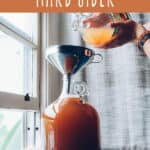
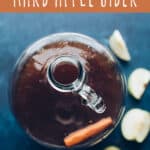
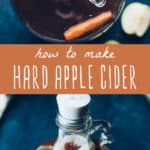
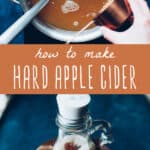
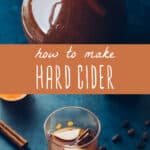
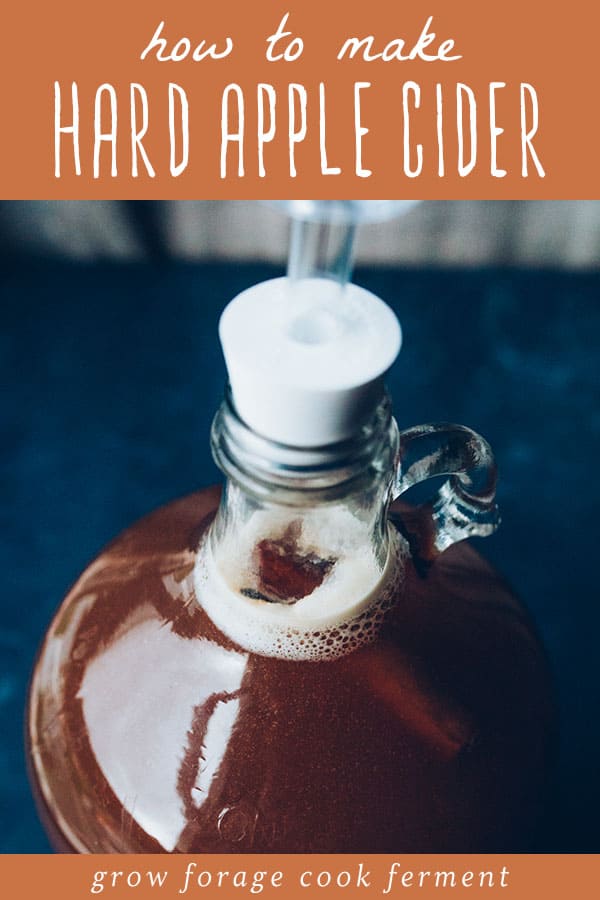
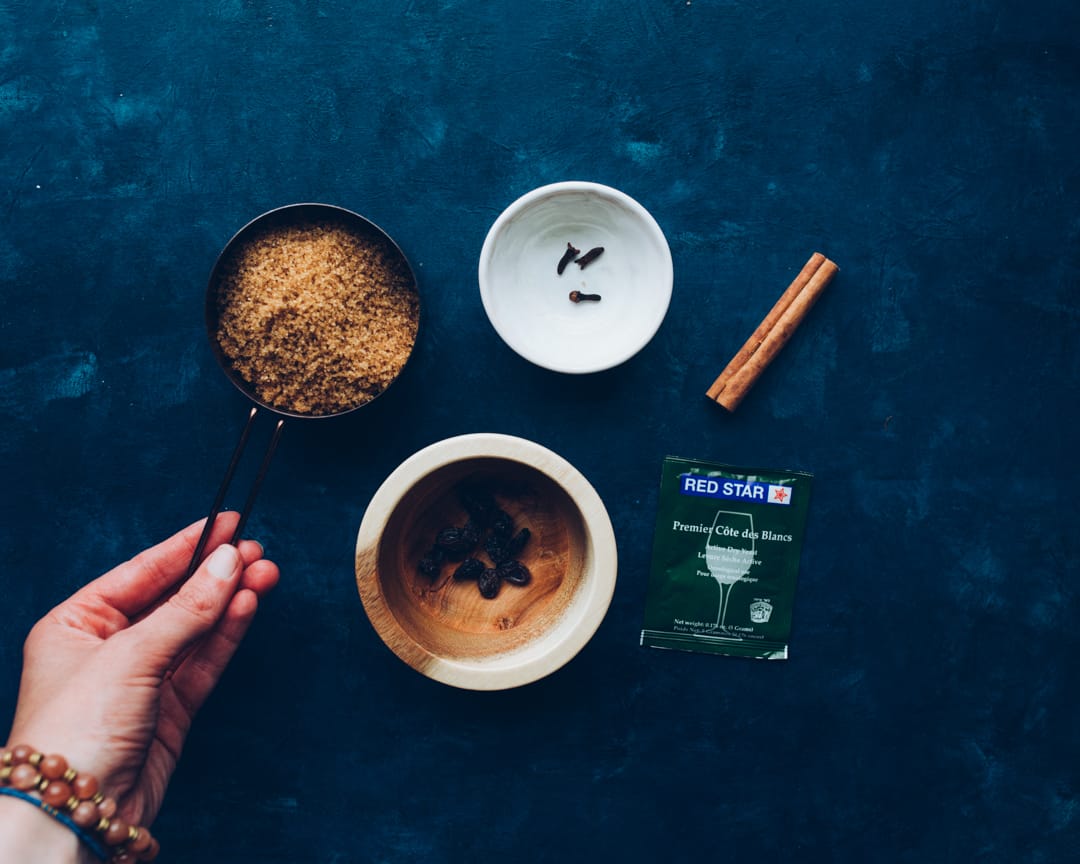
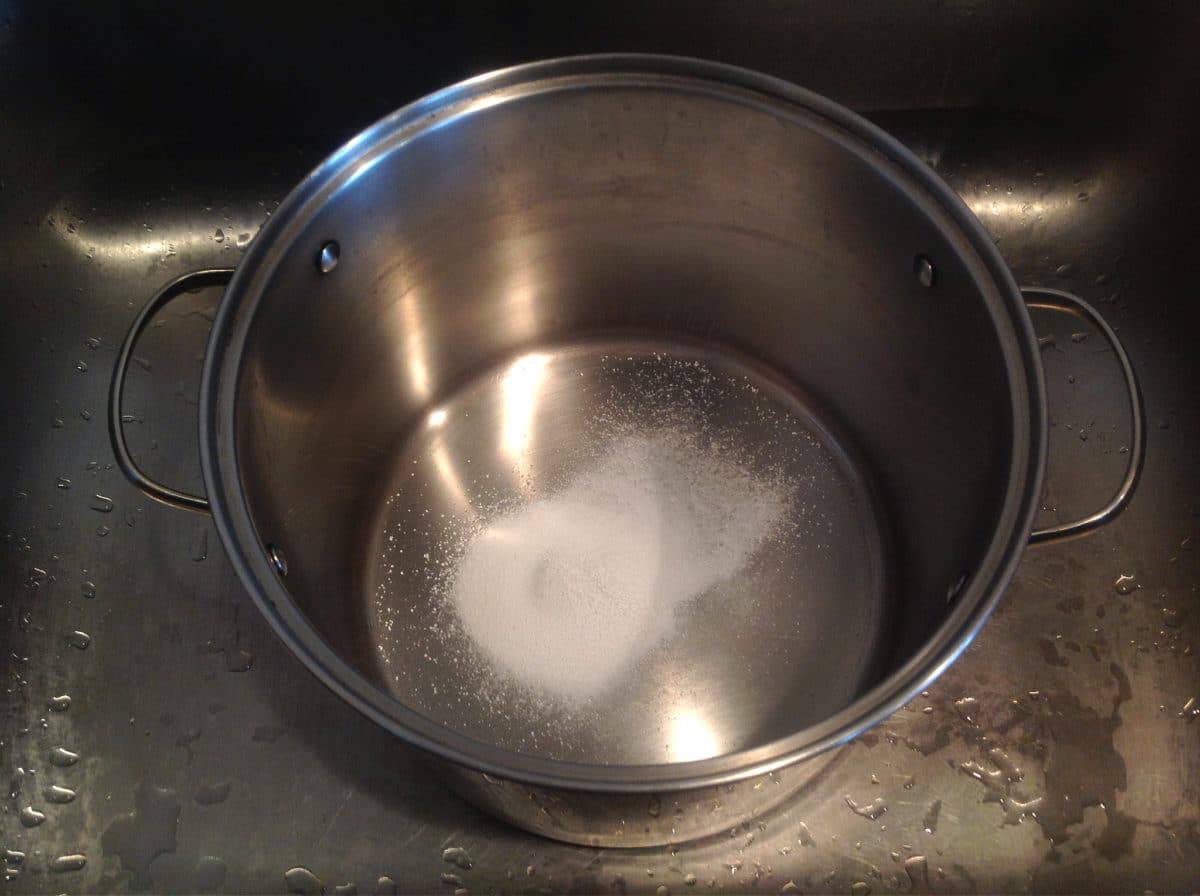
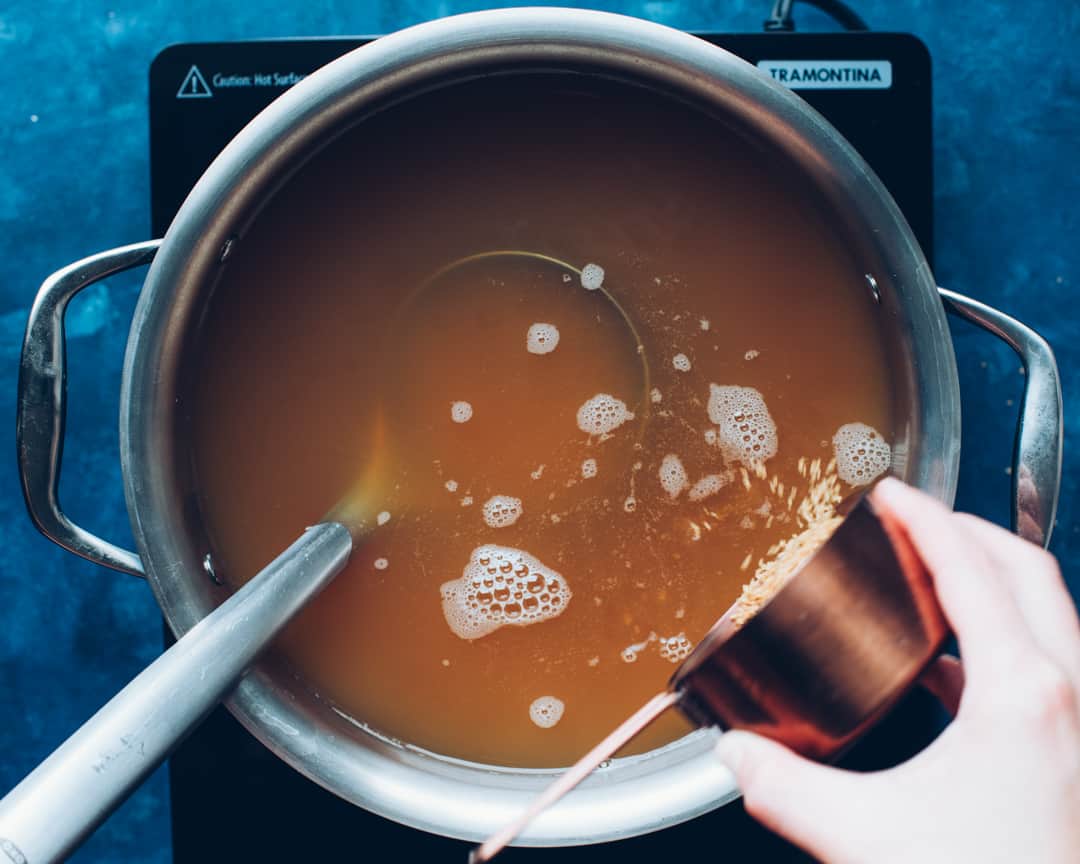
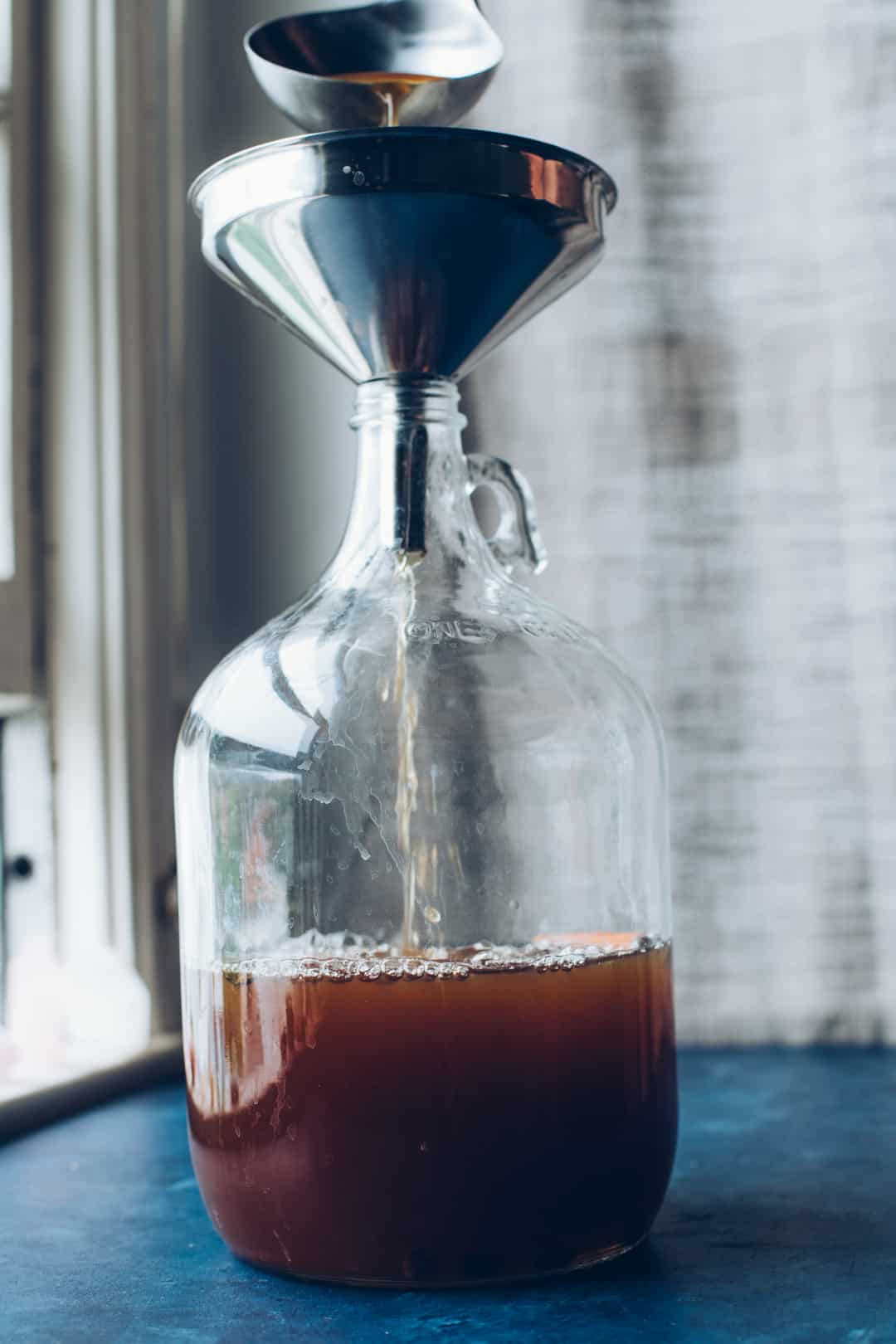
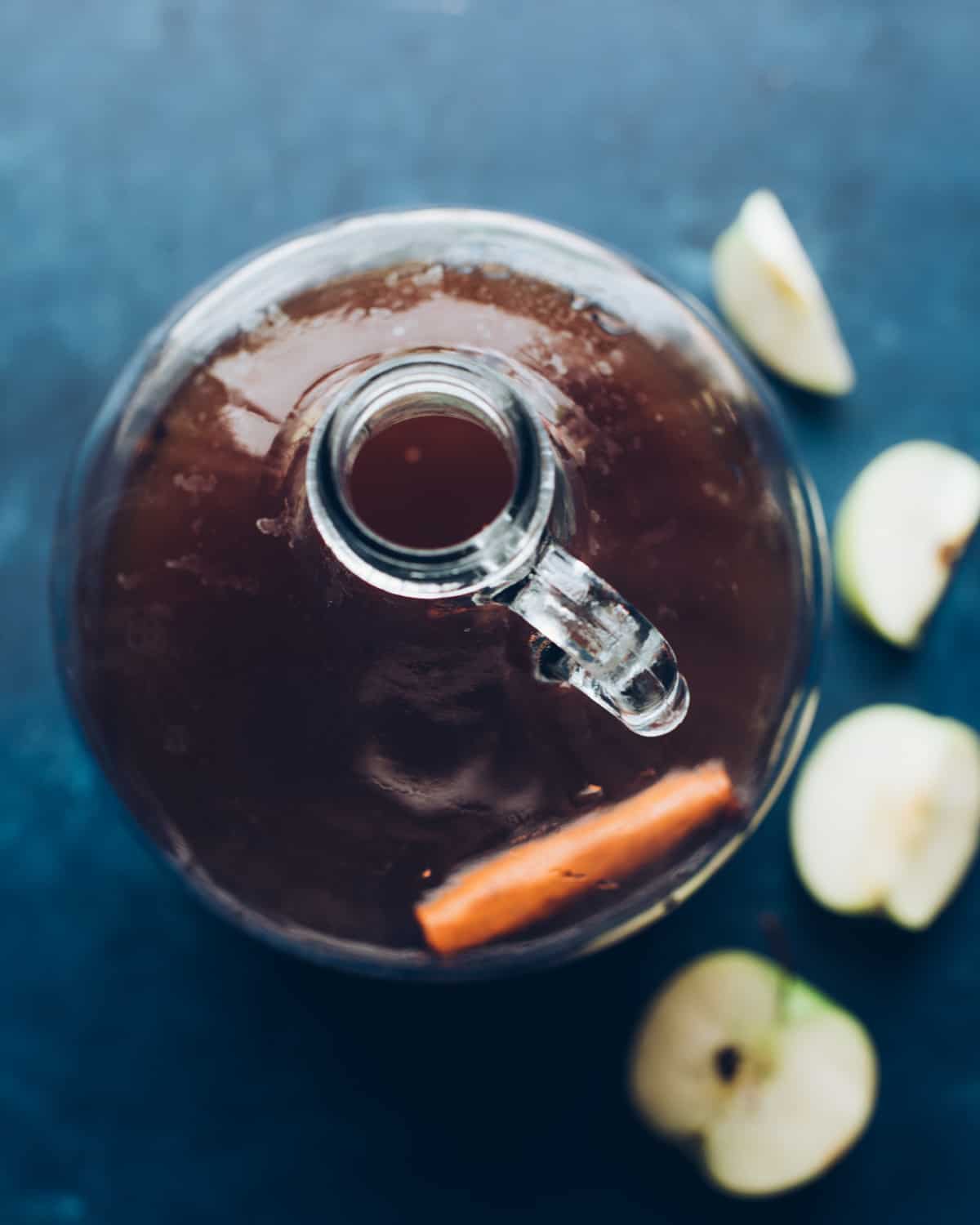
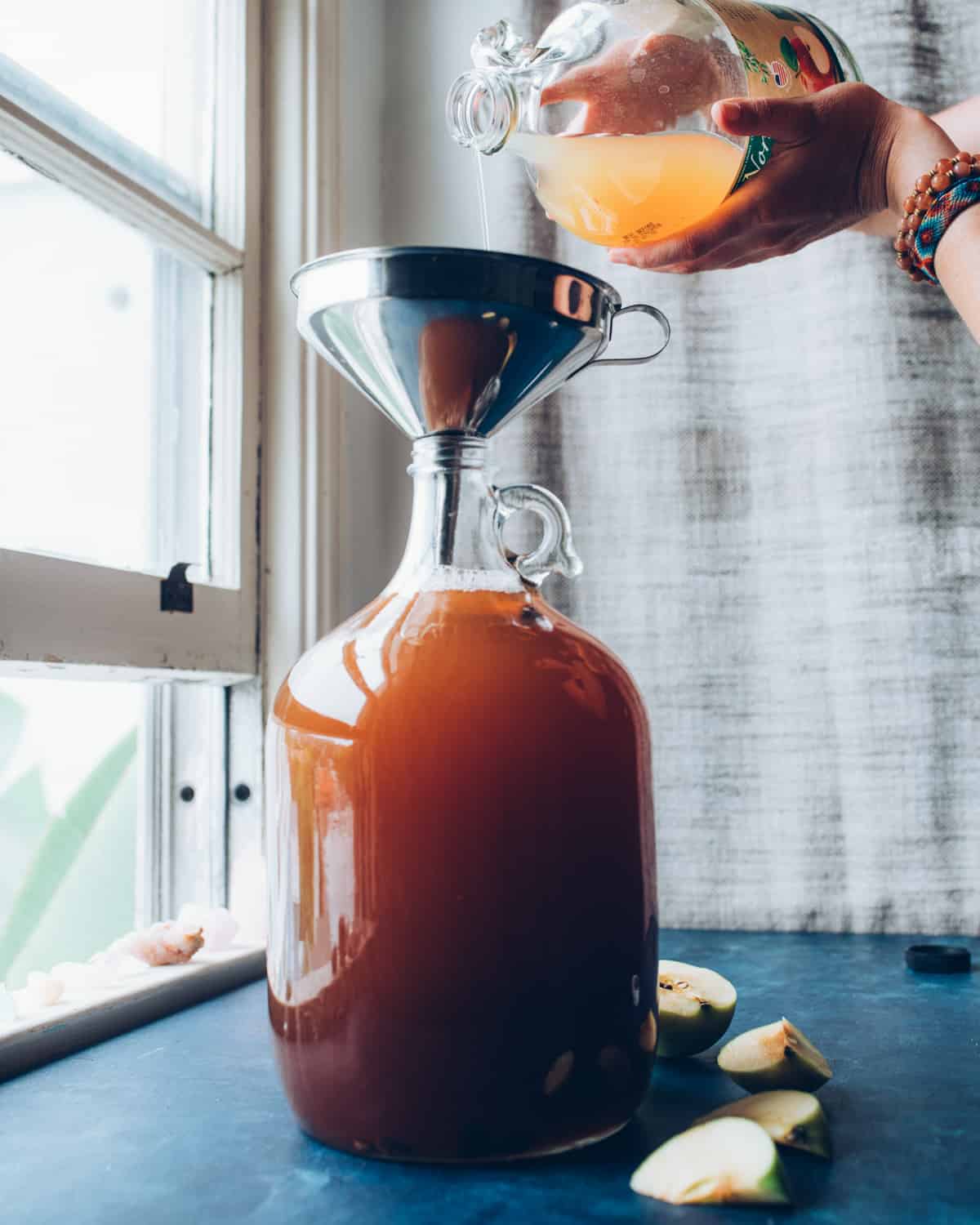
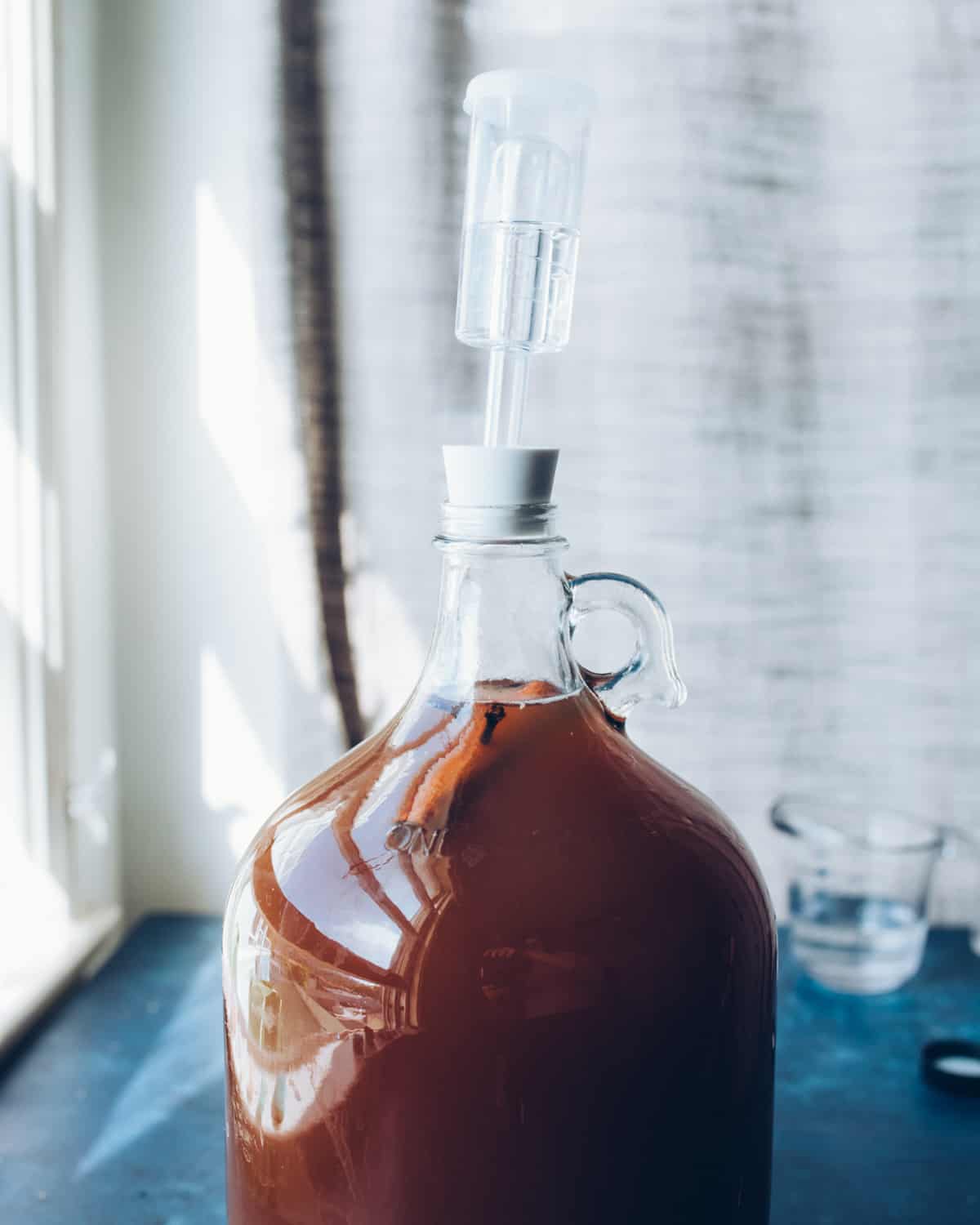

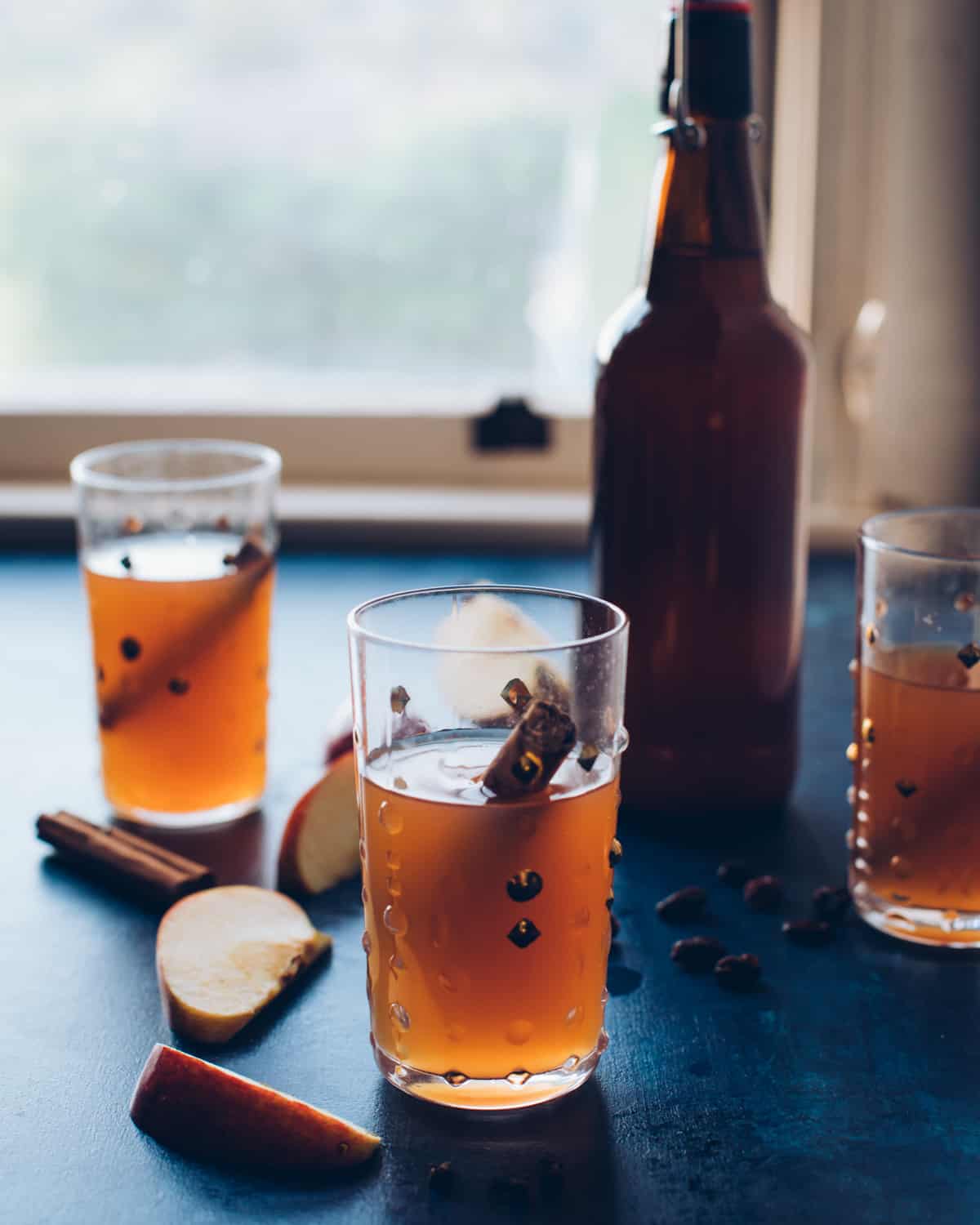
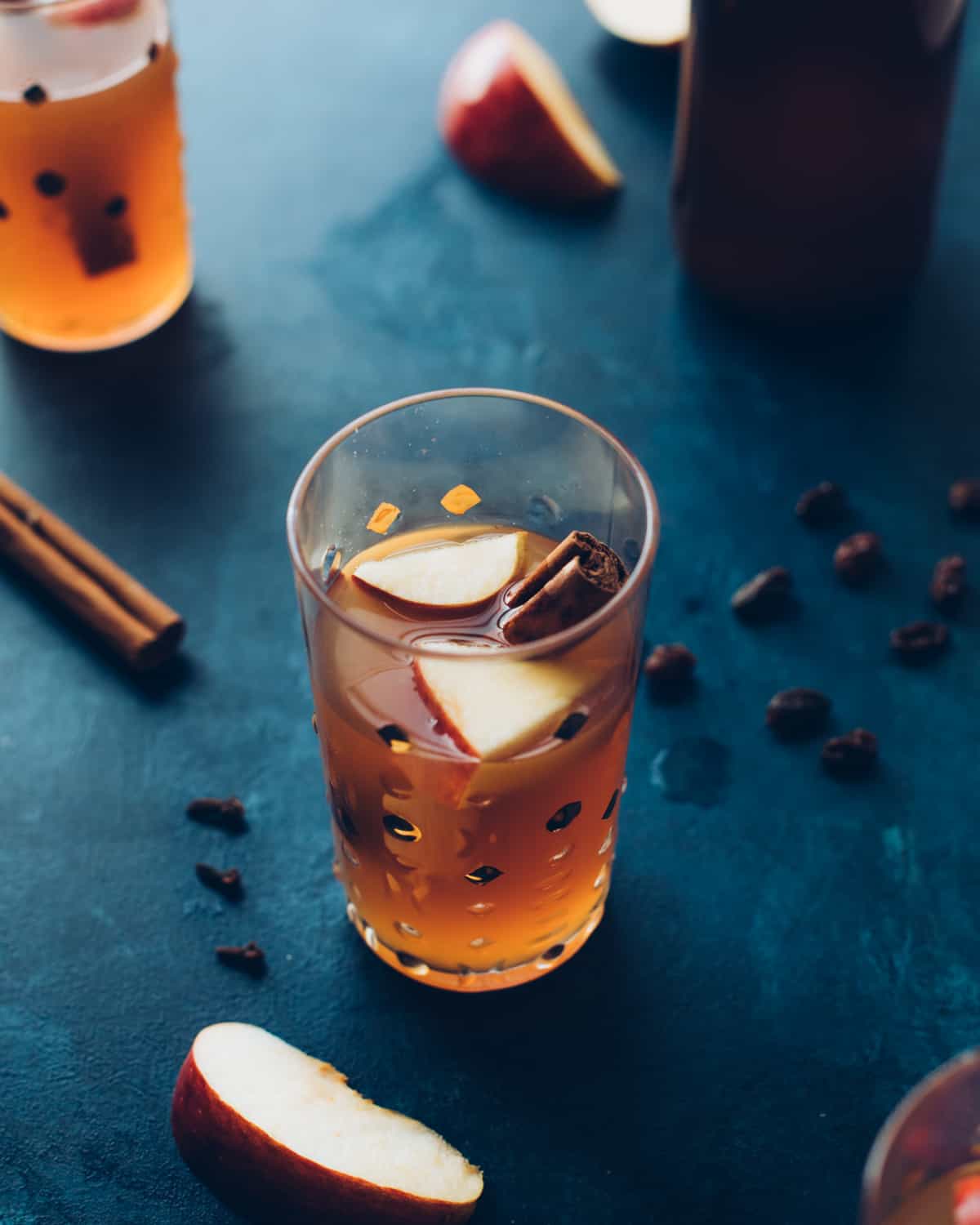
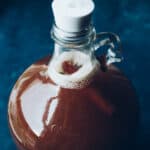

I’m trying my first batch this weekend. Question, do you use light or dark brown sugar? I got light since I thought dark would make it too sweet. Thanks.
I used dark brown sugar, but light should still work!
I can’t find unpasteurized apple juice near me
Can I use pasteurized?
I was thinking about Simply, since its only ingredient is apple juice.
It should be fine as long as there are no preservatives.
After the cider is done fermenting, will it be carbonated or is there another process for this?
Get a hydrometer they’re cheap and extremely helpful.
Got 9 gallons brewing right now, have our own cider and like this better then wine. I don’t back sweeten, but do back carbonate. Tried that last year and it worked out great. Found that it mellows some with aging.
Discovered the apple juice from making apple sauce simply with Pink Lady apples , lemon, cinnamon, and water…was so delicious!!! I am an apple cider enthusiast !! Moving to Julian soon! Going to try this recipe 😋
Can you use monkfruit instead of sugar, or use it to replace part of the sugar?
I think you can, but I would do some research on how much to add. I’ve never tried using monk fruit myself, so I can’t say how much you should use.
Can I use craisins instead of raisins?
Yup!
Hello! Thanks for your recipes, we’ve made lots of mead and cider with them over the last couple years.
On the latest batch, I accidentally added too much sugar (way too much) – will this make the fermentation go much longer and produce a higher ABV?
Yes, that’s right.
Hi there! I just finished and bottled my cider and couldn’t help but take a sample to taste. It’s good but definitely more on the bitter side. It took about 2 weeks with a few days at the ends with no bubbles before I bottled. Any idea how to “back sweeten” or where I could maybe change things to make it a little sweeter?
Thanks!
I don’t back sweeten, but there are a lot of resources online that give instructions on doing so.
My cider turned out very dry. Can I put the tables in it to kill the yeast, then add more brown sugar to taste?
Hi Philip, you can try that, but I haven’t tested it so I’m not sure of the results.
Hi, i’d love to make a recipe but don’t have a way to get an airlock jar or sanitizer, does regular sanitizer and mason jars with latex gloves or balloons with holes work? according to reddit, it’s should.
I haven’t tried, but if Reddit says so, go for it!
I’ve used balloons with great success!
Once it’s been bottled does it need to be refrigerated? How long is it good for after bottling? Thanks!
Hi Willow. No, hard cider does not need to be refrigerated after bottling. It’s good for 1 to 2 years, but will become increasing drier as it ages.
Do I need to remove the steeped spices before leaving my brew to ferment?
Hi there. Sorry about that. I should have clarified that I just let them steep undisturbed for 20 minutes. but I leave them in.
Can I put it in a warmer dark area, like 75 degrees?
Hi Roxy. It’s a little warmer than you need, but it should be fine.
Would a pasteurized juice work, or would that be included in the preservatives category?
Yes, that’s fine, just no preservatives!
Going to try this for the first time! Can I use a local orchard sweet apple or pear cider? Fresh pressed so I’m thinking that would be a more appley flavor.
Yup as long as there are no added preservatives.
I’ve followed the recipe pretty exactly, but my cider is not foaming the way it is pictured in the recipe. However, my airlock has been intensely bubbling for the past 24 hours (started yesterday). Should I be worried?
Nope, sounds completely normal!
I made the apple cider recipe per the instructions, but my cider is not foaming the way it is pictured on the website. However, the airlock is releasing a continuous stream of gas. The cider has been like this for the past 24 hours (started yesterday). Should I be concerned?
Nope, totally normal!
Hi, if I’m pressing my apples myself, should i pasteurized it first to kill bacterias or wild yeast?
Thanks!
I wouldn’t.
Is it possible to make this in 1/2 gallon mason jars with fermenting wide mouth lids?
Yup. You’ll need to split all the ingredients to half.
Ca I use coconut sugar, friend has a severe reaction to refined sugars ?
You can, but beware that it’ll impart a caramelized, brown sugar taste to your finished cider.
Hi, how do I know when it’s finished fermenting? I’ve just hit the 2 week mark and have noticed a significant drop in activity, I don’t see any bubbling anymore. Is that a safe mark of it having finished fermenting?
Also is it safe to leave for an extra week at this point if it’s finished fermenting?
Yes, when bubbles stop coming up to the top, it’s finished fermenting. It’s safe to let it sit for an extra week because the fermentation process preserves it. I would move on to the next step, bottling!
Can’t wait to try. What is the proof of 5he final product
I didn’t take an ABV of the final hard cider, sorry!
I followed the recipe and ended up with 13.4% ABV. So not actually hard cider, but apple wine made out of cider.
was it tasty?
Hello,
Very thorough recipe…luv the condensed version at the end!
I have been making wine for 34 years.
I am about to take a shift in making cider for the first time.
Question:
I see there is no reference of using any preservatives.
Have you ever had an issue with secondary fermentations/popping of corks??
Hi David. I’ve never had an issue with the corks popping!
Hi, thanks for the recipe I just made a batch up and I am looking forward to it. Just a question, what is the original gravity?
Hi Kyle. I didn’t take a gravity reading before making the hard cider.
I got a 1.082